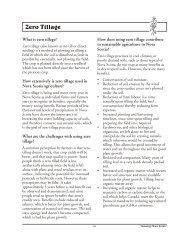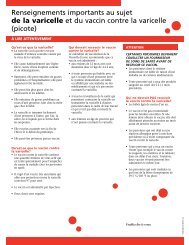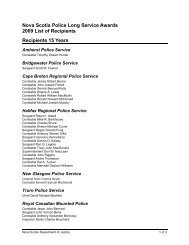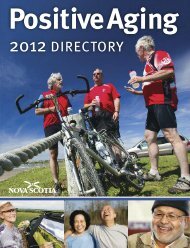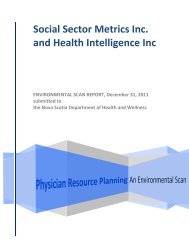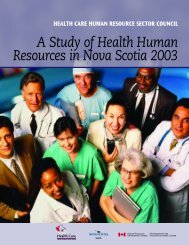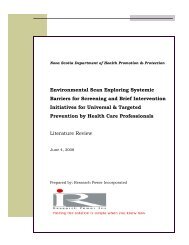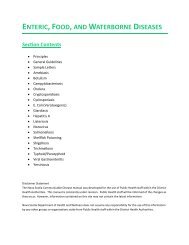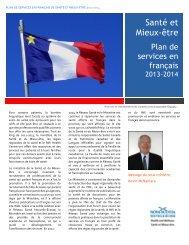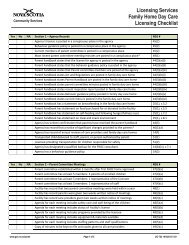Nova Scotia's Renewed Injury Prevention Strategy - Government of ...
Nova Scotia's Renewed Injury Prevention Strategy - Government of ...
Nova Scotia's Renewed Injury Prevention Strategy - Government of ...
- No tags were found...
Create successful ePaper yourself
Turn your PDF publications into a flip-book with our unique Google optimized e-Paper software.
Taking It to the Next Level <strong>Nova</strong> Scotia’s <strong>Renewed</strong> <strong>Injury</strong> <strong>Prevention</strong> <strong>Strategy</strong><strong>Strategy</strong> PrioritiesThe priorities in the framework are based onsurveillance, research, and consultation. Thesepriorities have been established to guide injuryprevention planning and resource allocation.Priority IssuesInjuries that have the greatest human, social, andeconomic impact in <strong>Nova</strong> Scotia are considered thehighest priority for action in all <strong>of</strong> the strategicdirections. These priority issues are• seniors’ falls• suicide and attempted suicide• road safetyPriority PopulationsPriority populations are groups that are known,through evidence, to be at greatest risk <strong>of</strong> injury.The priority populations are• children and youth• older <strong>Nova</strong> Scotians (seniors)• other populations at increased risk <strong>of</strong> injuryPriority SettingsUsing a settings-based approach is considered bestpractice in health promotion. A focus on settingsprovides strategic opportunities to integrateprevention efforts in contexts where people grow, live,work, play, and age. The idea is not only thatprevention efforts should take place within settings,but also that settings themselves are importantinfluences on whether injury occurs. Priority settingsare• schools• workplaces• homes• communities• roads and streets• health care settings• recreation and leisure settingsA word about workplace injuriesWorkplace injuries are a serious concern in <strong>Nova</strong>Scotia. While not specifically addressed in thisstrategy, we recognize the important efforts <strong>of</strong>WCB and its partners to reduce workplaceinjuries. Much <strong>of</strong> the work identified in therenewed injury prevention strategy will positivelyimpact the safety and health <strong>of</strong> workers in <strong>Nova</strong>Scotia.Reducing human suffering and the costassociated with workplace injury is what drivesthe WCB. With clear input from stakeholders, theWCB has set aggressive goals—by 2016, a 22%reduction in the number <strong>of</strong> people hurt on the joband a 26% reduction in lost time due to injury.This will mean by 2016 5000 fewer <strong>Nova</strong> Scotiansinjured on the job every year and 1300 fewerpeople losing time from work due to injury.The work <strong>of</strong> the WCB provides a solid example <strong>of</strong>a comprehensive approach to injury prevention.This includes helping to create a workplace safetyculture in <strong>Nova</strong> Scotia. Their approach includesraising awareness <strong>of</strong> workplace safety among<strong>Nova</strong> Scotians and promoting safe work practiceson the job. WCB has implemented policies that<strong>of</strong>fer rate incentives to reward employers whotake positive steps to improve their workplaces,while encouraging employers who do not, to takeimmediate action.Health care as a setting forinjury preventionThe policies and practices in a variety <strong>of</strong> settingshave a direct impact on injury prevention (e.g.,seniors’ falls prevention, addictions and mentalhealth, fitness to drive).Health care settings include primary care,emergency and acute care, and continuing careenvironments.40



